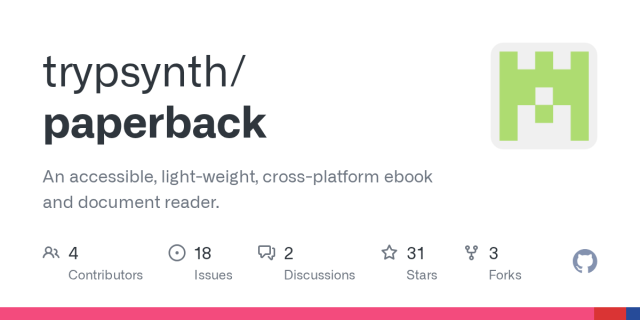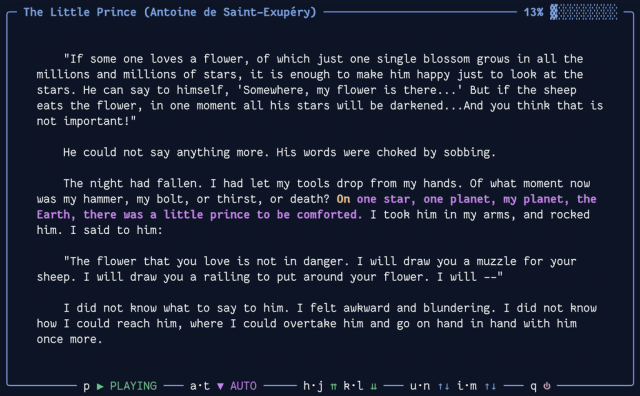reshared this
reshared this
reshared this
During last 3 months I am using VDO ninja for all my remote interwiev and podcast recordings. here is my article about it from the blind perspective, focused on accessibility and audio.
Have You Ever Wanted to Record an Interview or Podcast Online? You’ve probably faced a few challenges:
How to transmit audio in the highest possible quality?
How to connect in a way that doesn’t burden your guest with installing software?
And how to record everything, ideally into separate tracks?
The solution to these problems is offered by the open-source tool VDO Ninja.
It’s an open-source web application that uses WebRTC technology. It allows you to create a P2P connection between participants in an audio or video call and gives you control over various transmission parameters.
You can decide whether the room will include video, what and when will be recorded, and much more.
In terms of accessibility, the interface is fairly easy to get used to — and all parameters can be adjusted directly in the URL address when joining.
All you need is a web browser, either on a computer or smartphone.
The basic principle is similar to using MS Teams, Google Meet, and similar services.
All participants join the same room via a link.
However, VDO Ninja distinguishes between two main types of participants: Guests and the Director.
While the guest has limited control, the director can, for example, change the guest’s input audio device (the change still must be confirmed by the guest).
VDO Ninja works in most browsers, but I’ve found Google Chrome to be the most reliable.
Firefox, for some reason, doesn’t display all available audio devices, and when recording multiple tracks, it refuses to download several files simultaneously.
Let’s imagine we’re going to record our podcast, for example, Blindrevue.
We can connect using a link like this:
https://vdo.ninja/?director=Blindrevue&novideo=1&proaudio=1&label=Ondro&autostart=1&videomute=1&showdirector=1&autorecord&sm=0&beepFor guests, we can send a link like this:
https://vdo.ninja/?room=Blindrevue&novideo=1&proaudio=1&label&autostart=1&videomute=1&webcamlabel=Peter or label=Marek.
Simply open the link in a browser.
In our case, the director automatically streams audio to everyone else.
Participants also join by opening their link in a browser.
If a nickname was predefined, they’ll only be asked for permission to access their microphone and camera.
Otherwise, they’ll also be prompted to enter their name.
Usually, the browser will display a permission warning.
Press F6 to focus on it, then Tab through available options and allow access.
The page contains several useful buttons:
To change your audio devices:
Each guest appears as a separate landmark on the page.
You can navigate between them quickly (e.g., using D with NVDA).
Useful controls include:
Under Audio settings, you can:
Our URL parameters define automatic recording for all participants.
Recordings are saved in your Downloads folder, and progress can be checked with Ctrl+J.
Each participant’s recording is a separate file.
For editing, import them into separate tracks in your DAW and synchronize them manually.
VDO Ninja doesn’t support single-track recording, but you can use Reaper or APP2Clap with a virtual audio device.
To simplify synchronization:
autorecord.&autorecord, reload the page, and confirm rejoining.
To start recording manually:
In this article, I’ve covered only a few features and URL parameters.
For more details, check the VDO Ninja Documentation.
reshared this

A win32 app to capture audio from specific processes to an audio file - masonasons/AudioCaptureGitHub
ondrosik likes this.
reshared this
@FreakyFwoof .wav audio output is ok
.mp3 output fails to even record
not tryed flak.
also, just the chrome process has been selected no other and yet nvda can be herd in the recording loud and clear???
Peter Vágner reshared this.
like this
reshared this
Do you know that you can use Subtitle edit to transcribe audio? It has a relatively accessible guy so you can use Purfwiev's faster whisper xxl, cpp, cpp cublas, const-me. Longer post how to use it follows:
Download the program from the developer’s website. Navigate to the level 2 heading labeled “Files.”
If you want to install Subtitle Edit normally, download the first file, labeled setup.zip.
There is also a portable version available, labeled SE_version_number.zip.
If you decide to use the portable version, extract it and move on to the next section of this article. The installation itself is standard and straightforward.
NVDA cannot automatically obtain focus in lists.
To find out which item in the list is currently selected, move down with the arrow key to change the item, then press NVDA+TAB to hear which one is focused.
In the folder containing your original file, you’ll now find a new file with the .srt extension.
This is a subtitle file—it contains both the text and the timing information. Since we usually don’t need timestamps for transcription, we’ll remove them in Subtitle Edit as follows:
If you’re transcribing multiple recordings, it’s a good idea to close the current subtitle file by starting a new project using Ctrl+N or by choosing File → New.
Downloaded models can, of course, be reused, so future transcriptions will go faster.
In this example, I used Purfwiev’s Faster Whisper. If you want to use a different model, you can select it from the model list, and Subtitle Edit will automatically ask whether you’d like to download it.
Peter Vágner likes this.
Peter Vágner reshared this.
For various reasons, finding gainful employment as a disabled person tends to be difficult for most people, so I wanted to write down my experiences.Mike Gorse (Chronicles from an unstable era)
Peter Vágner likes this.
Peter Vágner reshared this.
On my AMD Ryzen 7 8845HS mini PC, NVDA is a bit sluggish in some cases in Firefox; e.g. cursoring through messages in Gmail folders. For reasons I don't fully understand, setting the processor affinity to a single CPU core and setting the process priority to "above normal" helps significantly, even when the CPU is nearly idle. I don't currently have the time/energy to debug the root cause for this or write a proper add-on, but I wrote an NVDA global plugin to make the change for me automatically when NVDA starts. If it breaks something, you get to keep all the pieces.
```
import ctypes
import globalPluginHandler
class GlobalPlugin(globalPluginHandler.GlobalPlugin):
def __init__(self, *args, **kwargs):
super().__init__(*args, **kwargs)
p = ctypes.c_void_p(ctypes.windll.kernel32.GetCurrentProcess())
ctypes.windll.kernel32.SetProcessAffinityMask(p, ctypes.c_void_p(1))
ctypes.windll.kernel32.SetPriorityClass(p, ctypes.wintypes.DWORD(0x00008000))
```
#nvdasr
reshared this
Peter Vágner likes this.
Peter Vágner reshared this.
Sending and receiving money has just become a whole lot easier!
Instant payments are now available to everyone in the eurozone.
⚡ Instant transfers 24/7, no waiting days for your money
💰 No extra fees, same price as regular payments
🔍 Free payee verification, ensuring IBAN and name match before sending
🛡️ Safer payments with daily checks to help prevent fraud and sanctions risks
🏦 More access, not just for banks but also fintechs and e-money institutions
For faster, safer payments than ever!
reshared this
Peter Vágner reshared this.

An accessible, light-weight, cross-platform ebook and document reader. - trypsynth/paperbackGitHub
Peter Vágner reshared this.
Peter Vágner reshared this.
Peter Vágner reshared this.
reshared this
Yeah you need (some of) these. 1, 2, 3, 135, and 136. If you use RADVD for addressing you also need 133 and 134
reshared this
Seirdy likes this.
reshared this
reshared this
I just pushed a new edit.video release. 🔥
- Faster video processing on modern browsers with Mediabunny
- New output quality controls
- Improvements to video trimming controls
- Optionally load demo video
- Drag n' drop to edit video files
- Sticky fullscreen mode
100% Free
No ads, no popups, no cookies, no account. The fastest way to edit video onlineEdit • Video
Peter Vágner reshared this.
reshared this
This is a concern for anyone using F-Droid, including users of Privacy Browaer Android.
F-Droid and Google's Developer Registration Decree | F-Droid - Free and Open Source Android App Repository – f-droid.org/en/2025/09/29/goog…

For the past 15 years, F-Droidhas provided a safe and secure haven for Android users around the world tofind and install free and open source apps. When cont...f-droid.org
Peter Vágner reshared this.
Welcome to #StroongeCast, a husband and wife team consisting of Andre and Kirsten Louis who live in London. On this podcast, we explore anything that makes us question the world—from relationships and parenting to school memories and beyond. Join our family chats for lively discussions, fun stories, and plenty of curious moments.
Going forward we will post all new episode links to this account before any others.
Subscribe: onj.me/stroongecast
Feel free to follow our main accounts here on the fediverse as well.
Andre: @FreakyFwoof
Kirsten: @MoonCat
Peter Vágner reshared this.
Did you know: There are many completely *free* sample libraries these days, some could help you end up in writing for your next film, documentary, podcast or TV show?
Andre wrote this piece of intro music for the podcast using purely *free* libraries and nothing else.
#InspiredBySound - Musical Breakdown - #StroongeCast Podcast Music: youtu.be/Ra7prQ6d9Pw

This piece of music is for the podcast 'StroongeCast' I co-created with my wife Kirsten. Every podcast needs a musical intro (or at least I believe so) and t...YouTube
reshared this

Hi, how are you doing? Thanks for visiting my channel, firstly. A bit about me then. I'm Andre Louis (AKA Onj), a visually impaired musician from London. What will you find here? Videos on this channel fall into a few categories.YouTube
StroongeCast reshared this.
Peter Vágner likes this.

reshared this
libxml2's sole maintainer Nick Wellnhofer steps down, meaning libxml2 is now no longer maintained.
discourse.gnome.org/t/stepping…
It's hard to estimate just how many companies depend on this software and critical security updates to the library, so I'm certain many will quickly step up and offer sponsorship to ensure a fundamental dependency doesn't just deteriorate without proper support.
Any day now.

I’m stepping down as maintainer of libxml2 which means that this project is more or less unmaintained for now. I will fix regressions in the 2.15 release until the end of 2025.GNOME Discourse
reshared this
Peter Vágner reshared this.
The XMPP Interop Testing project helps ensure XMPP servers and clients play nicely together by providing specification test automation.
New update:
✔️ Option to fail runs if some tests were "impossible" to execute.
✔️ Flexible account provisioning
Details on the blog: xmpp-interop-testing.github.io…
The development journey that @fishbowler and I have been taking was made possible by a grant from @nlnet 🙏. The grant has now concluded, and we’re deeply thankful for their support!
reshared this
We had to start charging the electric car from the grid this week due to bad weather and shorter days, but between this week and mid-April, when we got the car, we charged it exclusively from solar power. Six months and six thousand kilometers. Not bad.
#ElectricVehicle #electromobility #renewables #photovoltaic #renewableenergy
Peter Vágner reshared this.
Anyone using #Tammy as a #Matrix messenger client?
What do you think about it? Why do you use it? How much do you use it? On which device type is it installed? What features do you miss?
Peter Vágner reshared this.
After a short break, I’m returning to accessibility training services.
I provide one-on-one training for blind and visually impaired users across multiple platforms. My teaching is practical and goal-driven: not just commands, but confidence, independence, and efficient workflows that carry into daily life, study, and work.
I cover:
iOS: VoiceOver gestures, rotor navigation, Braille displays, Safari, text editing, Mail and Calendars, Shortcuts, and making the most of iOS apps for productivity, communication, and entertainment.
macOS: VoiceOver from basics to advanced, Trackpad Commander, Safari and Mail, iWork and Microsoft Office, file management, Terminal, audio tools, and system upkeep.
Windows: NVDA and JAWS from beginner to advanced. Training includes Microsoft Office, Outlook, Teams, Zoom, web browsing, customizing screen readers, handling less accessible apps, and scripting basics.
Android: TalkBack gestures, the built-in Braille keyboard and Braille display support, text editing, app accessibility, privacy and security settings, and everyday phone and tablet use.
Linux: Orca and Speakup, console navigation, package management, distro setup, customizing desktops, and accessibility under Wayland.
Concrete goals I can help you achieve:
Set up a new phone, tablet, or computer
Send and manage email independently
Browse the web safely and efficiently
Work with documents, spreadsheets, and presentations
Manage files and cloud storage
Use social media accessibly
Work with Braille displays and keyboards
Install and configure accessible software across platforms
Troubleshoot accessibility issues and build reliable workflows
Make the most of AI in a useful, productive way
Grow from beginner skills to advanced, efficient daily use
I bring years of lived experience as a blind user of these systems. I teach not only what manuals say, but the real-world shortcuts, workarounds, and problem-solving skills that make technology practical and enjoyable.
Remote training is available worldwide.
Pricing: fair and flexible — contact me for a quote. Discounts available for multi-session packages and ongoing weekly training.
Contact:
UK: 07447 931232
US: 772-766-7331
If these don’t work for you, email me at aaron.graham.hewitt@gmail.com
If you, or someone you know, could benefit from personalized accessibility training, I’d be glad to help.
#Accessibility #Blind #VisuallyImpaired #ScreenReaders #JAWS #NVDA #VoiceOver #TalkBack #Braille #AssistiveTechnology #DigitalInclusion #InclusiveTech #LinuxAccessibility #WindowsAccessibility #iOSAccessibility #AndroidAccessibility #MacAccessibility #Orca #ATTraining #TechTraining #AccessibleTech
reshared this
Welcome back - hope it was a good break!
Are you (or would you consider becoming) an NVDA Certified Expert for your NVDA work? We publish a list of those who are, with contact details for those who would like to share them / provide services, and it's usually the first place I look when someone asks for a local contact: certification.nvaccess.org/
Yt-dlp: Upcoming new requirements for YouTube downloads
Link: github.com/yt-dlp/yt-dlp/issue…
Discussion: news.ycombinator.com/item?id=4…
![[Announcement] Upcoming new requirements for YouTube downloads](https://fedi.ml/photo/preview/640/707466)
Beginning very soon, you'll need to have Deno (or another supported JavaScript runtime) installed to keep YouTube downloads working as normal. Why? Up until now, yt-dlp has been able to use its bui...bashonly (GitHub)
reshared this
lue is a TUI ebook reader with text to speech (TTS) support.
It can read EPUB / DOCX / PDF / TXT / files, supports 100+ languages, highlights words in sync, saves your progress, has themes and more.
Starry Eyes (superstarryeyes on GitHub) made lue using Rich, a Python library by @textualize and is Terminal Tool of the Week! ⭐️

A TUI ebook reader with Text-to-Speech (TTS).terminaltrove.com
reshared this
reshared this
 . GTS does not support relays yet sadly, although it is on their roadmap, I only realized it after I'd already configured most things so there was no turning back. That being said though, I do feel GTS is absolutely the right choice for my single-user scenario, setting up Mastodon or one of its forks would likely be overkill for my small Fedi home. That being said, I did find this project which seems interesting, maybe I should look into setting this up: codeberg.org/tante/hypebot
. GTS does not support relays yet sadly, although it is on their roadmap, I only realized it after I'd already configured most things so there was no turning back. That being said though, I do feel GTS is absolutely the right choice for my single-user scenario, setting up Mastodon or one of its forks would likely be overkill for my small Fedi home. That being said, I did find this project which seems interesting, maybe I should look into setting this up: codeberg.org/tante/hypebot
Letos volím poštou
xn--ondej-kcb.v.nizozemsku.nl/2025/09/21/Letos_volim_postou.html
Zatímco v Česku vrcholí horká fáze kampaně, já už mám odvoleno. Spolu s více než dvaceti tisíci krajany jsem se rozhodl letos poprvé vyzkoušet korespondenční hlasování. To se dostalo do novely zákona o správě voleb a umožňuje Čechům žijícím v zahraničí…
reshared this
Yeah, I've updated my @Arch Linux to @GNOME 49.
There are some nifty #a11y related tweaks such as better labelling for gnome shell menus, refreshed settings UI, I like how presentation of various lists e.g. List of wireless networks is presented with screen reader including signal strength.
Thanks to everyone involved for the improvements.
Peter Vágner reshared this.
Three things the blind community is known for:
1. Stevie Wonder.
2. those weird dots on your elevator buttons.
3. That guy on Mastodon.
Peter Vágner reshared this.
Hi, I'm micr0, the creator of Altbot.
Almost a year ago, your incredible generosity helped us raise the funds to buy the server that Altbot runs on today (locally and privately) It's been operating from my home ever since, and I'm so grateful for the support that made that possible.
But now, the situation has become unsustainable. My home network is under a sustained, targeted DDoS attack aimed at taking Altbot offline. And unfortunatly this isn't just a threat to the bot, it's a serious security and privacy concern for my family.
A lot of people are probabaly going to be asking the same question I did: "Who is doing this?"
but the honest answer is: I don't know, and I likely never will. These attacks are launched through botnets and proxies designed specifically to hide the source. Figuring out the "who" is nearly impossible. The only thing I can do is focus on the "how to stop it."
Running this critical service from a residential address is no longer viable. To protect Altbot and my family, we need to move the server to a professional data center with proper, enterprise DDoS mitigation.
The Goal: $2,880 to cover 12 months of secure colocation.
This will provide a secure, stable home for Altbot with:
Donations can be made via:
0xC992E57236eb9F30E79d0469446a6CF08Be05939This isn't just about maintaining a service. It's about ensuring that an important accessibility tool remains available for everyone who depends on it, while also protecting my family's privacy and safety.
Please consider supporting if you can. If you're unable to donate, boosts are incredibly valuable for raising awareness.
Thank you for your support and for believing in Altbot's mission.

hi i made altbot admin of wetdry.world and owner of fuzzies.wtf also post silly things on mastodonGitHub
reshared this
miki
in reply to Paweł Masarczyk • • •Isn't this what Aural CSS was back in the day?
AFAIK that was never implemented in any mainstream browser, Emacspeak was the only implementor I know of.
As far as I remember, it had a bunch of extra properties for things like how speech should be positioned in 3d, which was a very Emacspeak thing to do.
Paweł Masarczyk
in reply to miki • • •James Scholes
in reply to Paweł Masarczyk • • •There are people who seem to feel really strongly about this being a good thing for screen reader users, and I must admit to being bewildered about why. Websites changing aspects of screen reader output may be equitable, if we compare it with the way webpages can alter visual presentation through fonts and other aspects. But to me it feels entirely inappropriate to cross that boundary between the browser as the user agent and accessibility software in order to interfere with very personal settings.
Meanwhile on iOS, the related accessibility attributes are being used to achieve outcomes nobody wants or needs, like spaces between all the digits of a credit card number. @miki @prism
James Scholes
in reply to James Scholes • • •I can see the point for e.g. text-to-speech APIs built into the browser, maybe even read-aloud features. But the case for screen reader compatibility seems to be built on the foundational assertion that SR output is monotonous and can't be "livened up" by brands.
As assertions go, I think that is both true and exactly how it should be. I don't use a screen reader for entertainment. I can think of few things more obnoxious than a marketing person thinking that my screen reader should "shout this bit."
Many web authors can't even label stuff correctly. Why on earth would we expect them to treat this sort of feature with informed respect? @miki @prism
Drew Mochak
in reply to James Scholes • • •James Scholes
in reply to Drew Mochak • • •@prism I think without ARIA or an equivalent (like more things built into the web platform), the web would've continued galloping forward with all the same UI widgets and design patterns but with no way to make them even halfway accessible, and we'd be left even more behind than we are now.
By contrast, I don't think the inability for a website to change the pitch of NVDA is a legitimate blocker to anything worthwhile. @Piciok @miki
Drew Mochak
in reply to James Scholes • • •@Piciok @miki
Rebecca
in reply to Drew Mochak • • •miki
in reply to Rebecca • • •miki
in reply to miki • • •James Scholes
in reply to miki • • •@miki I think it's a trap to suggest that such problems should currently be solved only through speech properties and auditory cues within individual apps. Expressive semantics on the web have only been explored at a surface level so far, and it's a complete stretch to go from "We don't have the ARIA properties to convey complex information," to "Let's have every application implement its own beeps and boops."
Imagine having to learn the sound scheme for Gmail, then Outlook, then Thunderbird. Then going over to Slack where they also have unread state albeit for chat messages rather than emails, but they use an entirely different approach again.
All the while, braille users are getting nothing, and people who struggle to process sounds alongside speech are becoming more and more frustrated. Even if we assume that this is being worked on in conjunction with improvements to ARIA and the like, how many teams have the bandwidth and willingness to implement more than one affordance?
We've already seen this in practice: ARIA has braille properties, but how many web apps use them? Practically none, because getting speech half right and giving braille users an even more subpar experience is easier. Your own example highlights how few apps currently let you control things like verbosity and ordering of information.
CSS Speech could turn out even worse. A product team might opt to implement it instead of semantics because the two blind people they spoke to said it would work for them, and never mind the other few million for whom it doesn't. They'll be the people complaining that there's no alternative to the accessibility feature a team spent a month on and thought was the bee's knees.
@silverleaf57 @prism @Piciok
miki
in reply to James Scholes • • •James Scholes
in reply to miki • • •miki
in reply to James Scholes • • •@jscholes @silverleaf57 @prism Efficiency, not equity.
Words are a precious resource, far more precious than even screen real estate. After all, you can only get a fairly limited amount of them through a speaker in a second. We should conserve this resource as much as we can. That means as many other "side channels" as we can get, sounds, pitch changes, audio effects, stereo panning (when available) and much more.
Icon fatigue is real. "me English bad, me no know what delete is to mean" is also real, and icons, pictograms and other kinds of pictures is how you solve that problem in sighted land.
Obviously removing all labels and replacing it with pictograms is a bad idea. Removing all icons and replacing them with text... is how you get glorified DOS UIs with mouse support, and nobody uses these.
miki
in reply to miki • • •James Scholes
in reply to James Scholes • • •@miki Note that I'm specifically responding to your proposed use case here. You want beeps and boops, and I think you should have them. But:
1. I think you should have them in a centralised place that you control, made possible via relevant semantics.
2. I don't think the fact that some people like beeps and boops is a good reason to prioritise incorporating beeps and boops into the web stack in a way that can't be represented via any other modality.
@silverleaf57 @prism @Piciok
miki
in reply to James Scholes • • •James Scholes
in reply to miki • • •James Scholes
in reply to James Scholes • • •@miki As noted, I think people who can process a more efficient stream of information should have it available to them. That could be through a combination of normalised/centralised semantics, support for specialised custom cases, and multi-modal output.
My main concern remains CSS Speech being positioned as the only solution to information processing bottlenecks, which I think is a particularly narrow view and will make things less accessible for many users rather than more.
Good discussion, thanks for chatting through it. @silverleaf57 @prism @Piciok
Drew Mochak
in reply to James Scholes • • •@jscholes At the same time, I think the chances that CSSSpeech completely takes over the industry and we all stop doing text role assignments is quite low.
explainxkcd.com/wiki/index.php…
So I am decidedly meh about this. It could help but probably won't.
@miki @silverleaf57 @Piciok
927: Standards - explain xkcd
www.explainxkcd.comJames Scholes
in reply to Drew Mochak • • •Paweł Masarczyk
in reply to James Scholes • • •Drew Mochak
in reply to Paweł Masarczyk • • •This already exists though, as a screenreader feature. Kind of. NVDA has an add-on called unspoken that will replace the announcement of roles with various sounds, there's a different one for checked vs. unchecked boxes for instance. JAWS did (does?) something similar with the shareable schemes in the speech and sounds manager. Granted, not a lot of people do this, but the ability is there if people want it. VO, TB and cvox also have earcons--they're not used for this purpose, but they could be. Having this under the user's control rather than the author's control does seem better. It prevents for instance a developer deciding to be super abtrusive with ads. I do see the potential for it to be good, the author would be able to convey more nuanced concepts being the author of the content... it just feels like a thing most people wouldn't use, and most of the people who'd try would end up being obnoxious about it.
@jscholes @miki @silverleaf57
Paweł Masarczyk
in reply to Drew Mochak • • •Paweł Masarczyk
in reply to James Scholes • • •Paweł Masarczyk
in reply to James Scholes • • •Devin Prater :blind:
in reply to Paweł Masarczyk • • •Adrian Roselli, pH0
in reply to Paweł Masarczyk • • •Why we need CSS Speech - Tink - Léonie Watson
Tink - Léonie Watson - On technology, food & life in the digital age